Anger Triggers for Kids: Checklists, Worksheets and Anger Action Plan
Anger triggers in kids: Help children identify their anger triggers and teach them how to deal with those situations appropriately. This article features a collection of Anger Triggers Worksheets for Kids (free download at the end of the post).
These resources will help you explain to kids or students what triggers are, explore different types of triggers (including emotional ones), and dive deeper into understanding anger triggers. Plus, it includes a beautifully designed Anger Triggers Poster that’s perfect for classrooms or at-home learning!
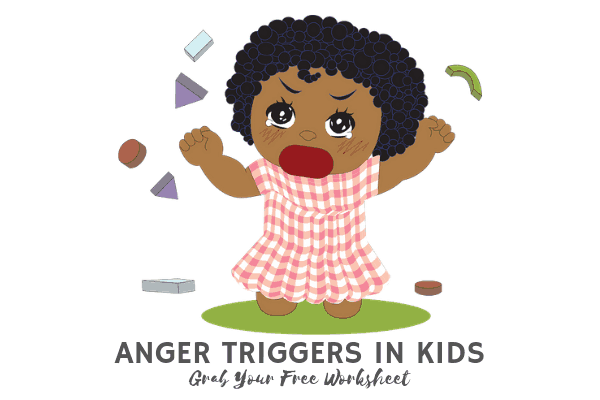
Table of Contents
- What is a Trigger & Types of Triggers
- Anger Triggers
- Why is it Important to Identify Anger Triggers
- Common Anger Triggers in Kids
- Brainstorming Anger Triggers with Kids/Students
- Anger Trigger Action Plan: What to Do After We Identify a Trigger
- 23 Anger Trigger Examples for Kids
- Anger Triggers Worksheets (Free Download)
What is a trigger? Types of triggers
How can I explain to my kids what a trigger is? A simple explanation and tip:
“A trigger is something that causes a reaction. For example, tickles are the trigger for laughter.”
Tip: Here, you could start tickling your kid. My kids took turns tickling each other and thought it was hilarious (and at points annoying!) By the time you finish with this nice tickling activity, you remind them that your tickles were the trigger to their laughter.
There are many types of triggers that kids (and adults) might experience:
- Physical Triggers
Things that happen to your body that cause a reaction.Example: Being tired, hungry, too hot, or too cold. - Environmental Triggers
Things around you in your surroundings that set off a reaction.Example: Loud noises, crowded spaces, or a messy room. - Social Triggers
Interactions with other people that cause feelings to surface.Example: Being teased, left out, or hearing someone say something hurtful. - Emotional Triggers
Events or situations that bring up strong feelings.Example: Feeling embarrassed after making a mistake or excited when you win a game. - Sensory Triggers
Things you experience through your senses (sight, smell, sound, taste, touch).Example: Smelling a certain food that reminds you of something happy or hearing a loud noise that startles you. - Memory Triggers
Things that remind you of something from the past, which causes a reaction.Example: Seeing a photo of a fun day at the park or hearing a song that reminds you of a sad time.
In this article, we will focus on triggers that can lead to feelings of frustration or anger.
What are anger triggers?
Anger triggers can be situations, moods, actions, or anything that makes your kid angry.
A way to explain this to your kid could be the following:
“Anger triggers are things that happen that make you feel angry. It could be something like someone being mean to you, losing a game, or feeling left out. Everyone has different anger triggers, and learning what yours are can help you figure out how to stay calm and handle your feelings in a better way.”
Why is it important to identify anger triggers?
Being able to identify anger triggers in kids is an important step in your anger management strategy as you will be able to:
- Avoid some anger-triggering situations, and consequently, prevent the anger outburst
- Help your kids identify those situations so that:
- They understand the reasons behind their discomfort – understanding their feelings makes coping with those feelings easier
- They can look for help at the initial stages before things have turned into a full-blown drama
- They can take action and deal with their emotions by utilizing learned strategies and coping skills.
You are probably fairly clear on what events or situations trigger those outbursts.
But what we are really going to focus on here is how to help THEM identify their own anger triggers and how to DEAL with those situations and events.
If they can identify their anger triggers, they will probably:
- Do things that prevent that situation
- Learn strategies to help them cope with their emotions
What are the most common anger triggers in kids?
When it comes to our little ones, some of the common triggers are:
- Tiredness
- Being hungry
- Stopping an activity that they enjoy
- Frustration
- Anxiety
- Sense of injustice
At the end of this post, you will be able to download our “Anger Triggers Worksheet for Kids” PDF, which includes:
- engaging anger triggers worksheets for kid
- examples of common anger triggers (checklist) and
- anger triggers poster.
Identifying Anger Triggers: a Brainstorming Session with your Kids
A brainstorming session with your kids can be quite a fun activity. You are probably clear on what things make your kids explode, but exploring their own anger triggers will:
- Help them become aware of those situations that can potentially make them angry
- Better engage them in creating action plans to deal with their triggers
These are some tips for your brainstorming session:
- Use a whiteboard to write down everybody´s anger triggers
- Ask your children what things make them feel angry, and explain that you will, as a team, prepare plans to deal with those situations.
- Take turns naming situations, events, moods or anything that comes to mind that could make you angry.
- Once you have built a nice list, you will be able to pick a couple of examples to explain two facts of life:
- Sometimes you can prevent triggers /situations, but
- Some other times it will be unavoidable.
Pick two examples from your list: - A trigger you can do something to fix /avoid
- A trigger that can´t be avoided and that will require coping strategies
- Prepare an action plan for both those examples that you chose (our own examples in the next sections)
- Keep working through your list in the future
Anger Triggers Examples Explained to your Kid
-
- An example of anger triggers that you can avoid:
“Remember how you said that you get grumpy when you get hungry?
Mommy can do some things so that it doesn’t happen.
Mommy can help you by making sure that dinner is ready by 6 pm (15 minutes earlier than usual), and if things get delayed you can munch a healthy snack while you wait! “ -
An example of a situation you can’t avoid:
Sometimes, you will not be able to prevent the situation. This is an example that works well to explain this to my son:
Trigger: “Remember how you said you get very angry when you hurt yourself?
Well, we can do our best to prevent that from happening.
But there will still be times in which you will hurt yourself.
In those situations, I will do my best to help you.
I will hug you, console you and help you with breathing exercises so that you feel less pain.
But we will not be able to avoid them”
- An example of anger triggers that you can avoid:
Dealing with Anger Triggers: an Action Plan
The examples I shared in the previous section already pre-empted the real objective of this exercise.
Identifying anger triggers doesn’t help much unless you do something about them.
In the first case (avoidable situations), we were teaching our children that once we identify a trigger, we may be able to find solutions.
In the second example, we were teaching our kids that when the situation that makes us angry is unavoidable, we may still be able to make it better thanks to our coping strategies.
Creating your Anger Triggers Action Plan
From your list, choose a trigger to work on an action plan. This is just an example that we worked on ourselves (that’s why it says Mommy- it’s a real example we worked on at home):
Action Plan for an Avoidable Trigger (Example 1):
- Trigger: I get angry when I talk to Mom and she does not respond immediately
- Facts: Sometimes, Mommy is doing something else and can´t respond to me immediately. It does not mean she doesn´t want to talk to me. I´m still super important to her, but I need to wait for my turn (unless it is an emergency like I´m hurting)
- Action Plan: What do I need to do to solve this situation?
- If Mommy is talking, I will wait till she has finished talking
- If Mommy is listening to my sister, I will wait until she has finished listening
- Then, I will say: “Excuse me, Mom,” to get her attention
- When Mum is looking into my face, it means that she is now ready to listen to me and respond
- Role-playing: We repeated this three times and then we role-played. I started talking to his sister and he had to follow those steps.
Action Plan for an Unavoidable Trigger (Example 2):
What to do when you cannot prevent the situation?
Sometimes it just happens; your kid hurts himself, gets frustrated, or you just can´t avoid the situation.
- Action Plan Options:
- I will let Mommy know how I´m feeling by taking my emotions chart
(Related reading: How to Use Emotion Charts Effectively) - I will take my calming-down kit and choose one of the strategies that we have practiced before.
(Related reading: Anger Management Activities for Kids)
- I will let Mommy know how I´m feeling by taking my emotions chart
- Role-playing: if there are triggers that are more likely to happen, you may try to role-play those situations.
Examples of Anger Triggers in Kids
Just in case you need a bit of inspiration, this is a list of very common anger triggers in kids:
Frustration:
1. Loosing in a game
2. Not getting good marks in an exam
3. Failing to perform /accomplish during an activity
4. It rains, can´t play outside
5. Waiting
6. Being told no
Injustice:
7. Somebody does something wrong to me/somebody
8. Somebody cheating in a game
9. Somebody makes fun of me
10. Being left out
11. Feeling ignored
Aversive situation:
12. Hunger
13. Pain / Getting hurt
14. Loud noises / Getting startled
15. Fear /Being scared
16. Feeling overheated
17. Feeling cold
18. Feeling tired
19. Anxiety
Not accessing a reward/activity we wanted:
20. Parent or caregiver does not let me…(watch tv, go to the swimming pool outing, jump on the trampoline, eat chocolate)
21. Stopping an activity they enjoy
22. Being sent to bed
23. Going to school (when I´m doing something I enjoy better)
Other FREE anger management worksheets and resources for kids
- Preparing a Calming Box
- Anger Signs: Teaching Kids to Identify their Anger Signs (How does my body tell me I am feeling angry?)
- Anger Iceberg for Kids
- Mood Charts for Kids / Mood Trackers
- Anger Volcano Worksheet and Activity
Anger resources for teens:
Anger Triggers Worksheet- Free Download
Download your “Anger Triggers Worksheet for Kids” below (updated and improved!). It includes:
- The checklist you have just read
- An anger triggers poster (with illustrations) to help the younger ones identify their anger triggers.
- Several worksheets to explore and reflect on the concept of triggers in a fun and engaging way.

Share Us on Pinterest! ♥
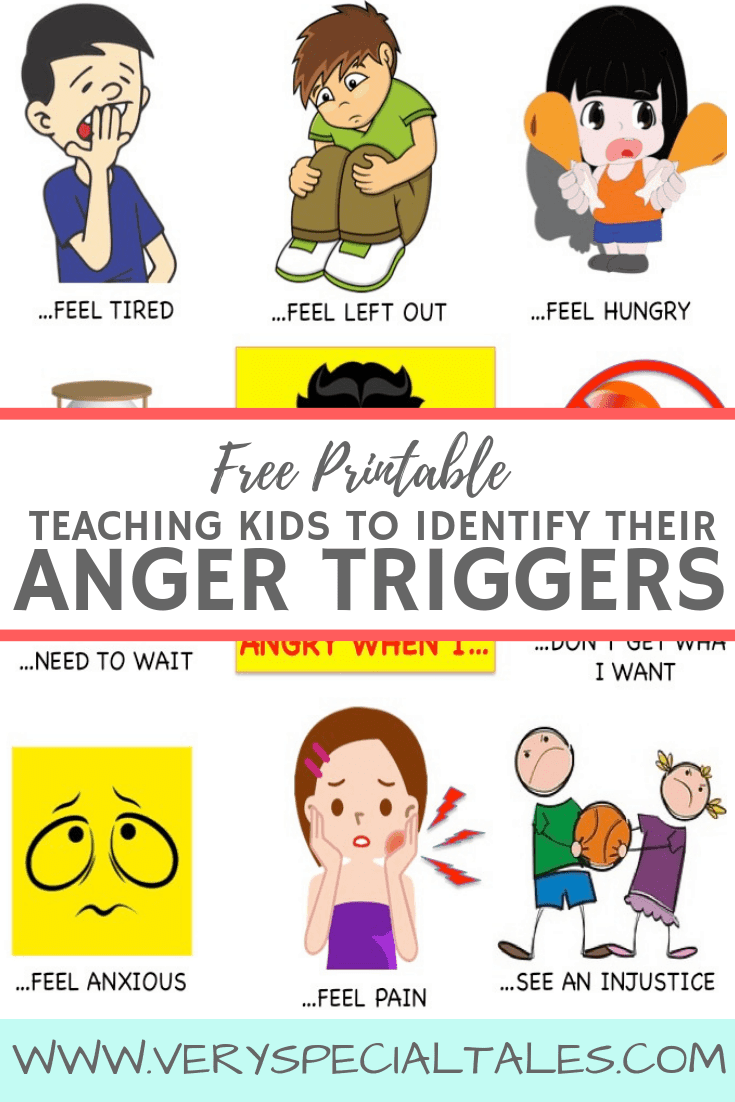
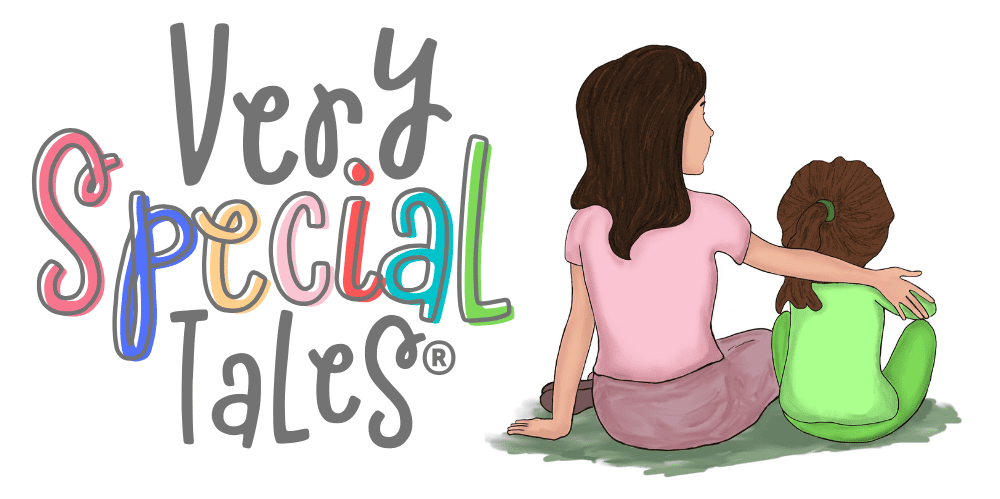
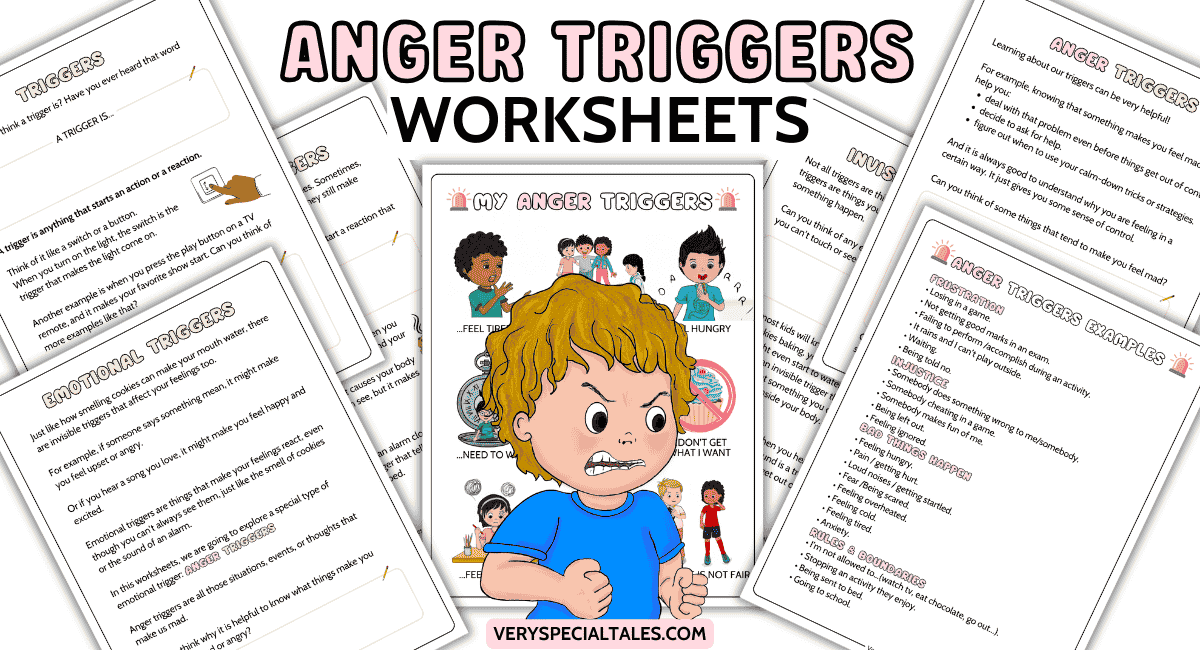

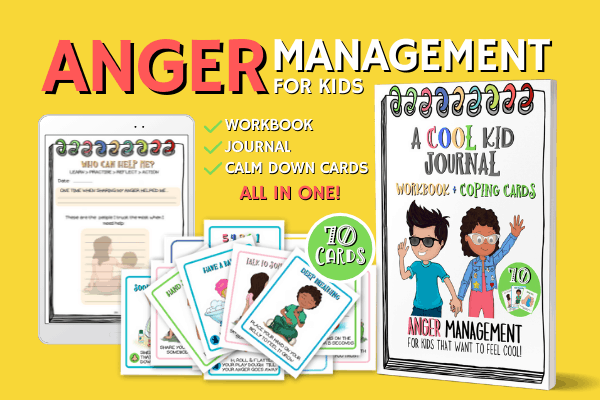
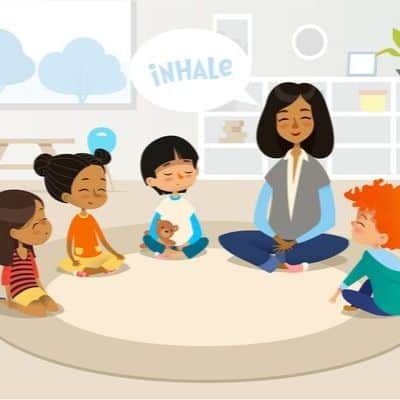
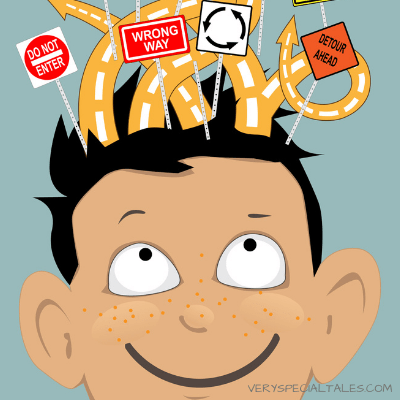
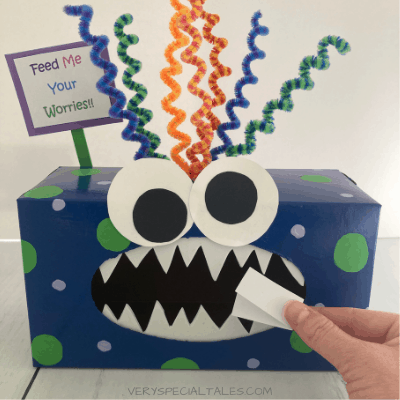


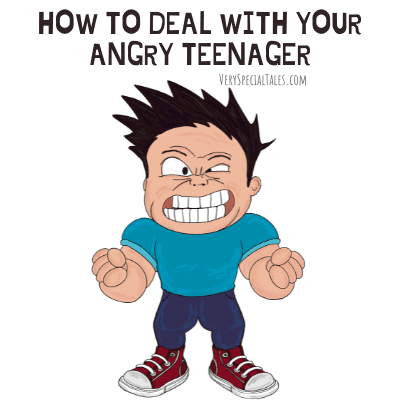
I love the anger iceberg and have used this in teacher workshops for years. They need the reminder too as they are showing children how to react and that is a lesson in itself!
I use this in my grief support groups now. Thanks!
Thank you for your kind words and your support, dear Gayle. I am glad to hear that the resources I am providing are helpful, and I look forward to sharing more valuable resources with you in the future.
Thank you so much for sharing.
I’m glad to hear that you found my article helpful and appreciate your kind words, dear Darlene.